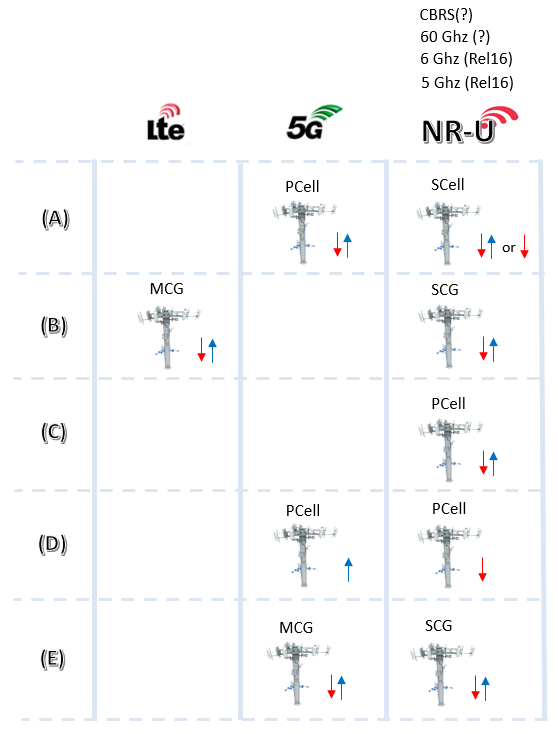|
|
||
|
I think NR-U in concept would be equivalent to LAA in LTE-U. In LTE, it had to develop a few major PHY/MAC features just for this (e.g, frame type 3, symbol level scheduling (DCI 3)), but in NR PHY/MAC change would not be as much as LAA case since NR frame structure and scheduling is already flexible enough to adjust it for various use cases. However, there should be various small modifications or new implimentation of PHY/MAC features for smooth coexistance between NR and other technology(e.g, WiFi, LTE-U) What is it for ?Main objectives of NRU(NR Unlicensed) based on RP-201834 can be summarized as follows.
Deployment ScenarioThe scenario studied and defined in RP-201834 can be summarized as follows.
Scenario A: Carrier aggregation between licensed band NR (PCell) and NR-U (SCell). Scenario B: Dual connectivity between licensed band LTE (PCell) and NR-U (PSCell) Scenario C: Stand-alone NR-U Scenario D: A stand-alone NR cell in unlicensed band and UL in licensed band (single cell architecture). Scenario E: Dual connectivity between licensed band NR and NR-U. The deployment scenario can be summarized in illustration as follows.
PHY layer considerationRP-201834 descirbes many aspects of Physical Layer aspects. Followings are what I think is important to notice. (NOTE : I haven't confirmed yet on whether all of these are specified in Release 16 TS document)
Presentations on YouTube[1] Webinar - Fixed 5G: From mmWave to NR-U [2] 5G NR-U and WiFi [3] The license-exempt spectrum: An opportunity for 3GPP [4] Sivers IMA On-Demand Webinar: Fixed Wireless Access (FWA), Licensed or Unlicensed 5G [5] TWS 2015: Role of Unlicensed Spectrum in 5G [6] Fixed Broadband LTE in Unlicensed 5 GHz Spectrum with Telrad Webinar [7] NEWSDR 2019 Technical Presentation 2: 5G NR-U "Houston, we have a problem here [8] 5G NR-U vs WiFi6 video Part 1 [9] 5G NR-U vs WiFi6 - Part 2 |5G | NR-U | WiFi6 | WiFI | [10] TWS 2015: Role of Unlicensed Spectrum in 5G Reference :[1] How does support for unlicensed spectrum with NR-U transform what 5G can do for you? (Qualcomm) [2] Unlicensed Use of the 6 GHz Band (FCC) [3] FCC Opens Spectrum Horizons for New Services & Technologies (FCC) [4] FCC Modernizes 5.9 GHz Band to Improve Wi-Fi and Automotive Safety (FCC) [5] List of WLAN channels (Wikipedia)
|
||
